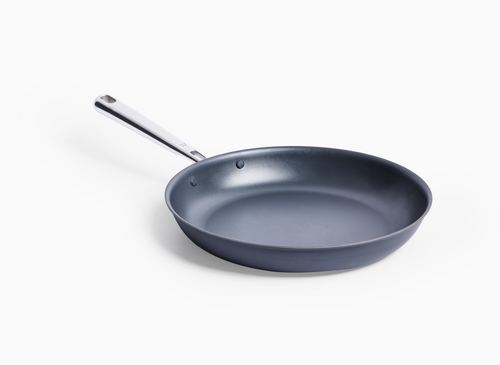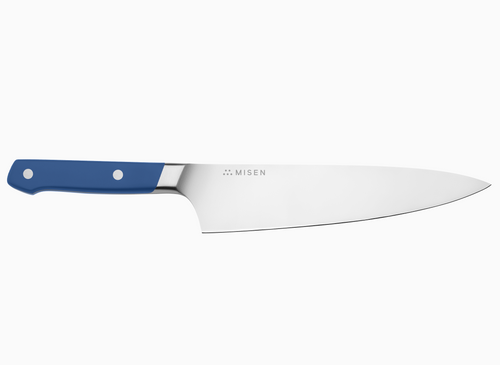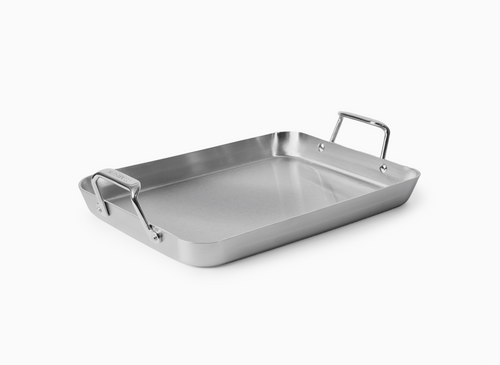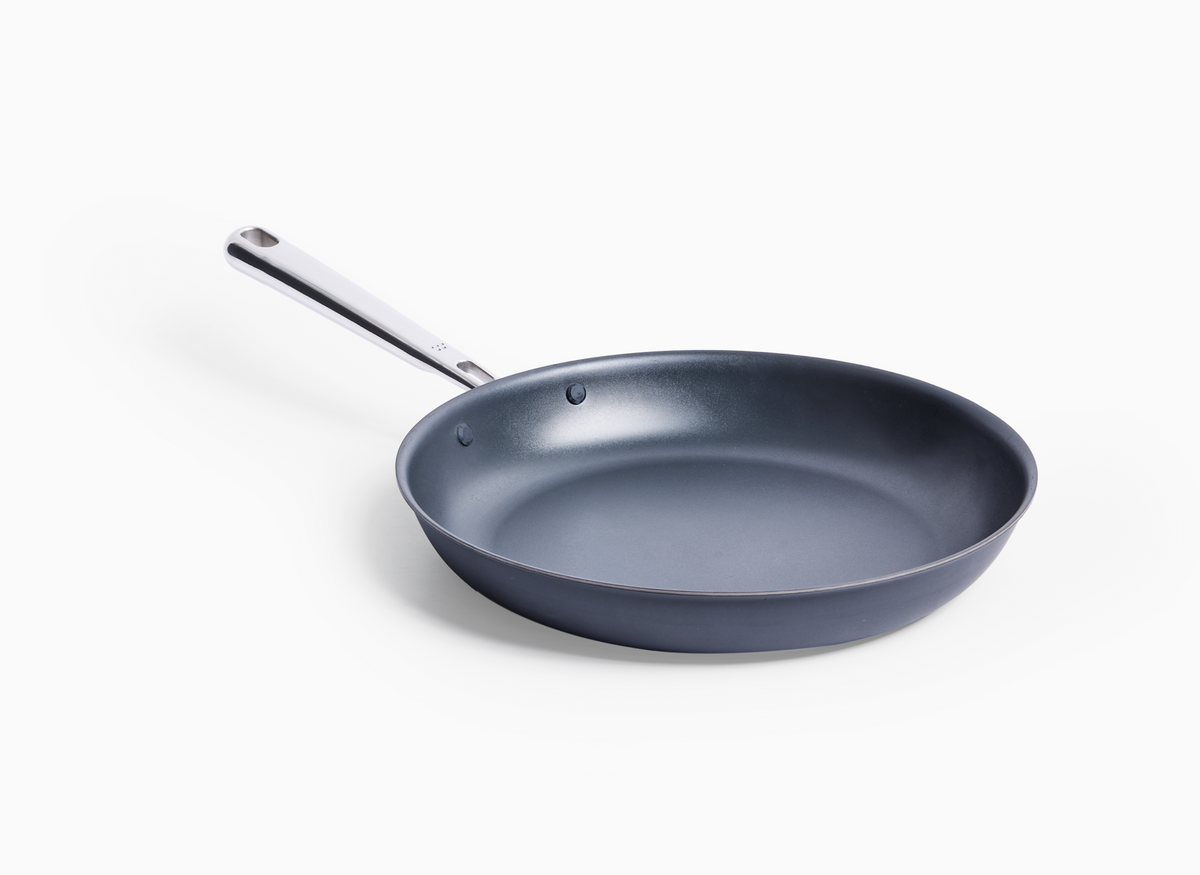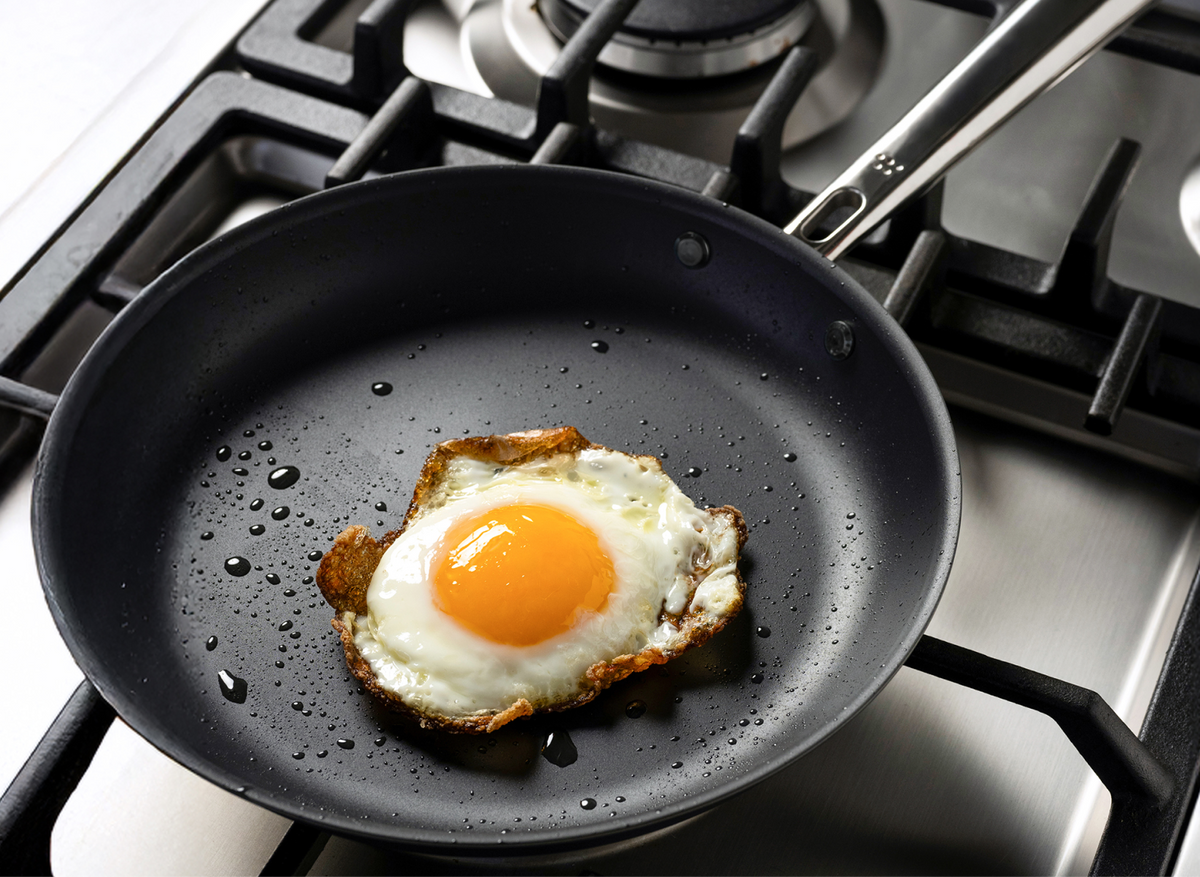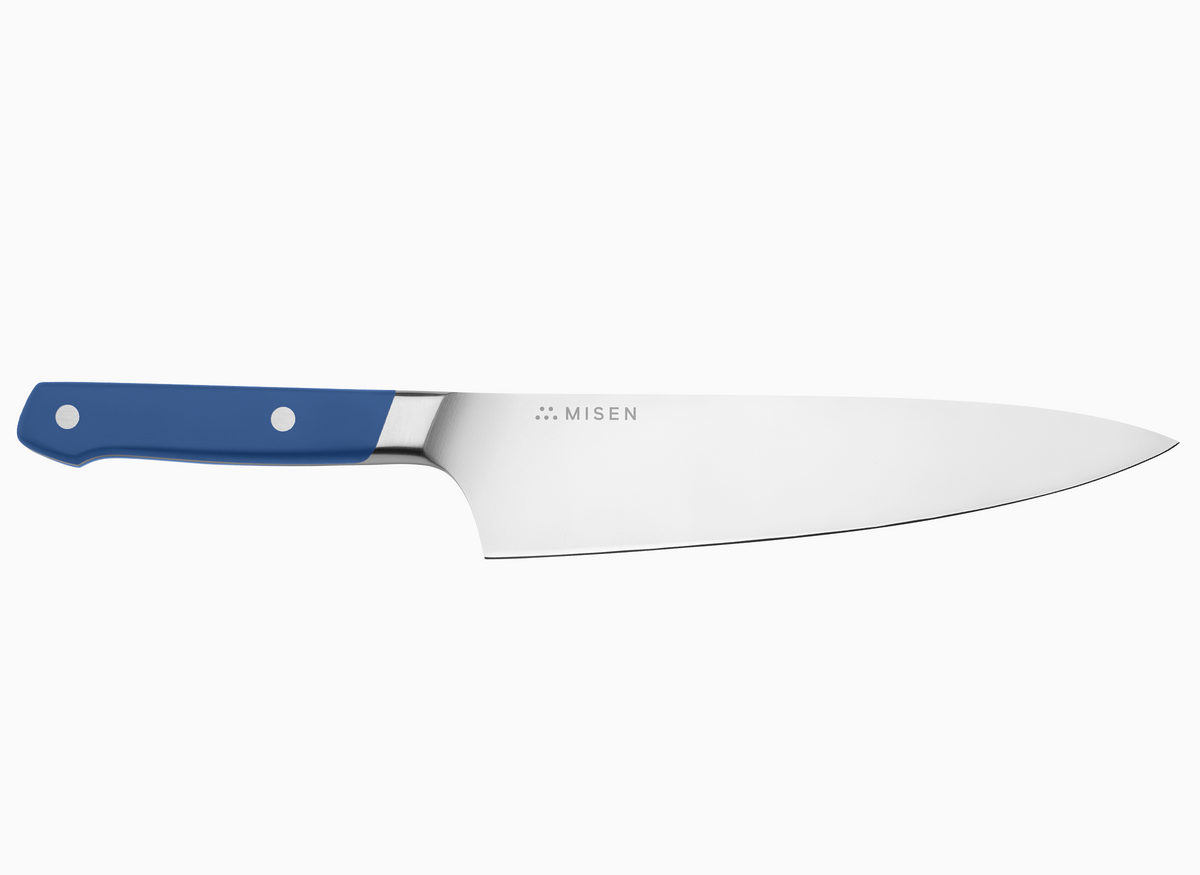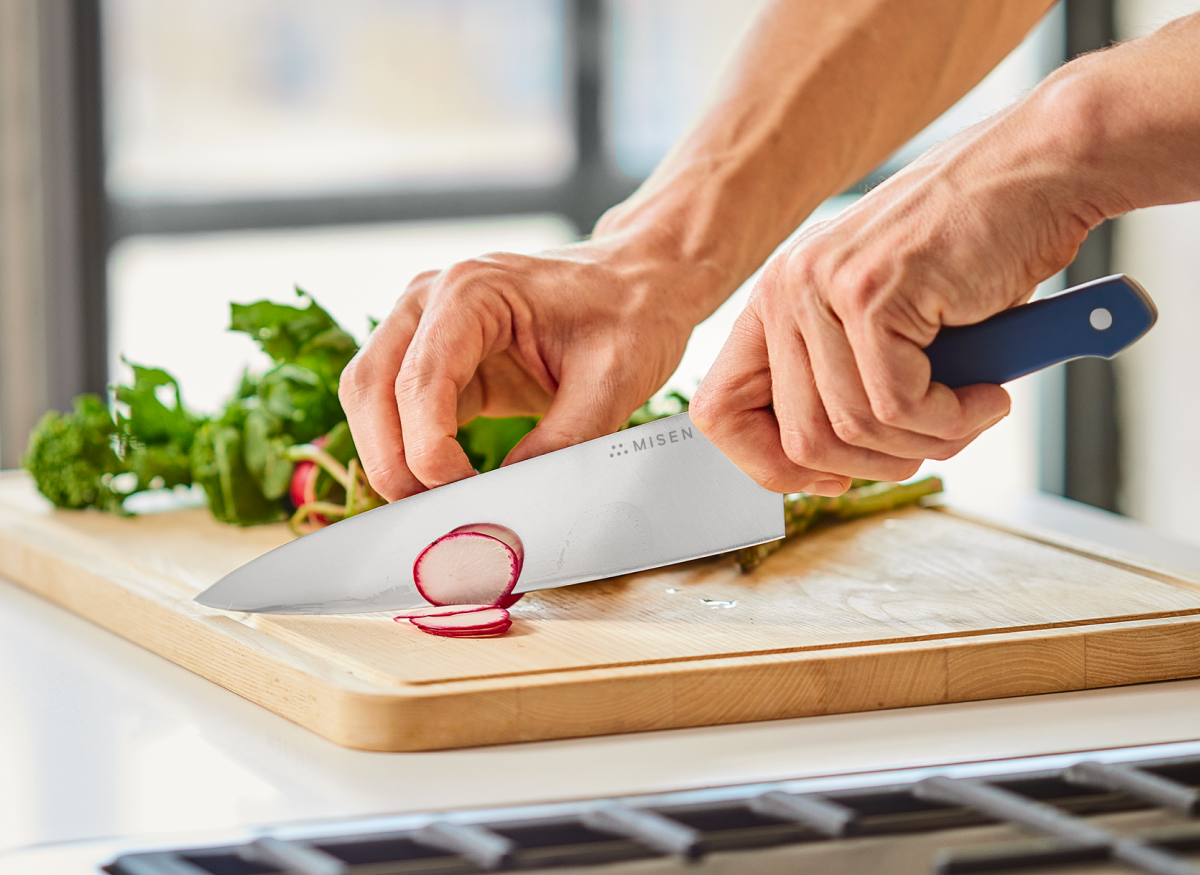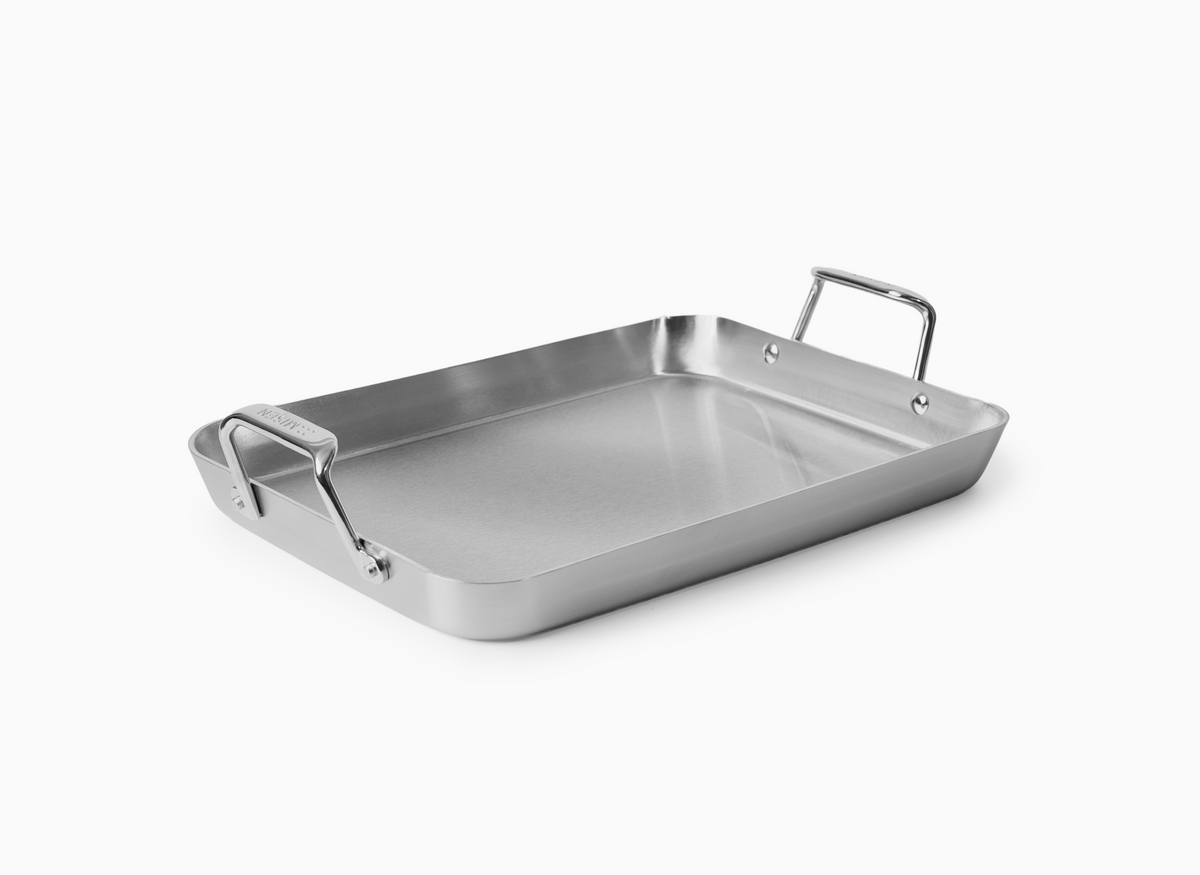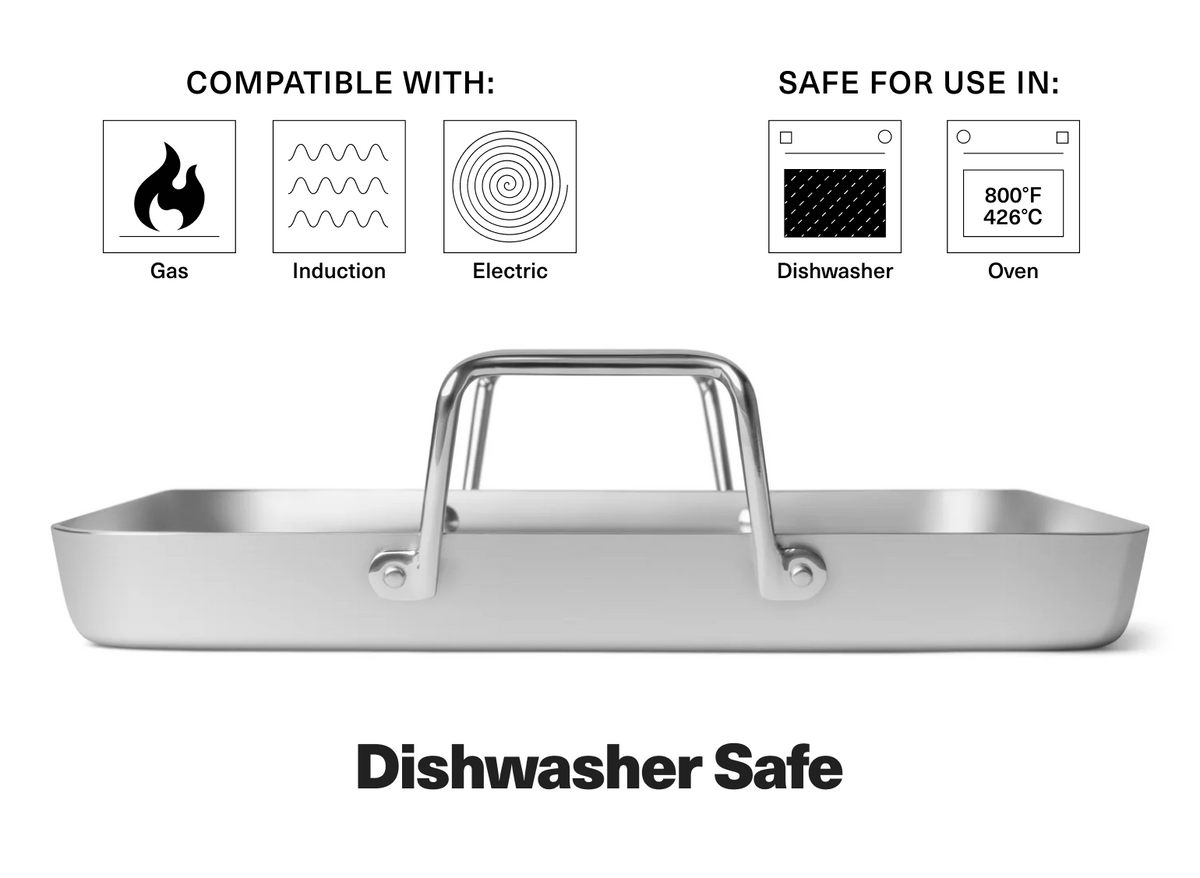Carbon Steel Pan Review: Testing the Nonstick Performance
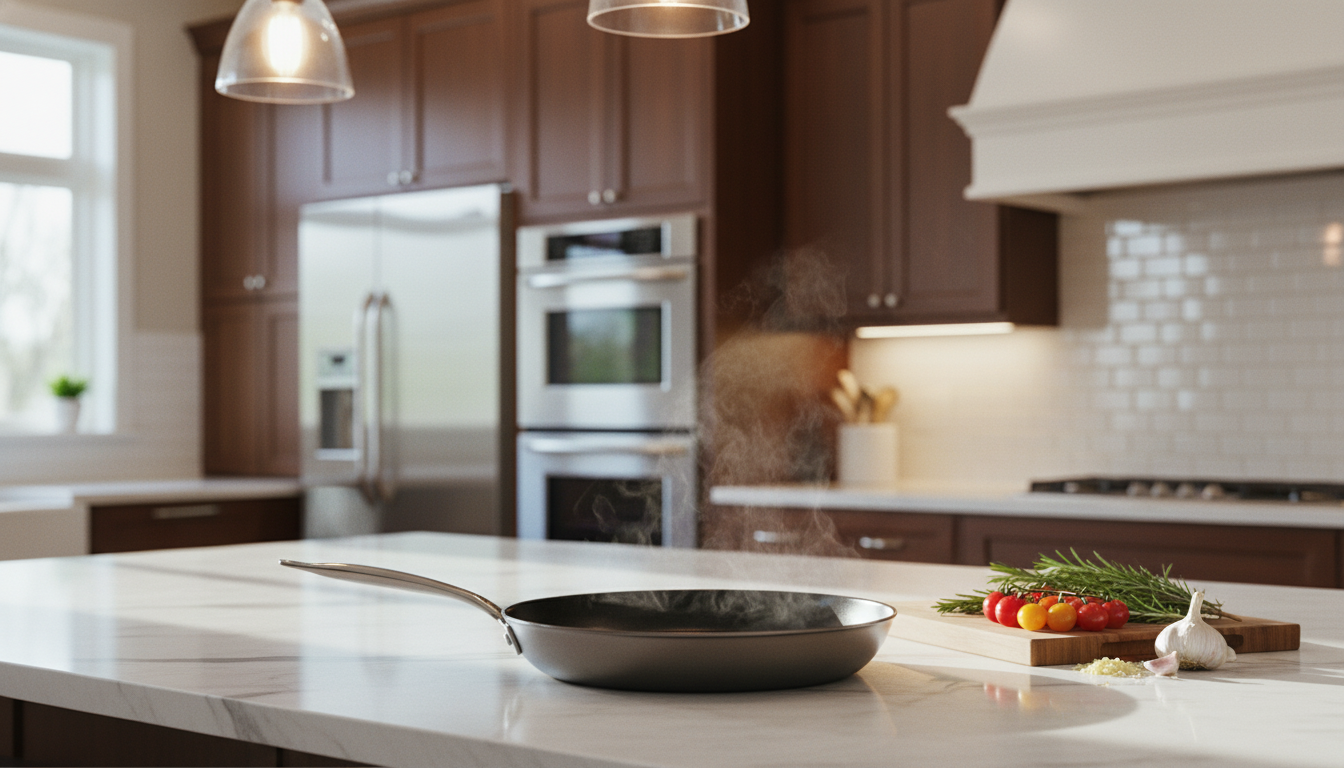
Introduction
Why Chefs Prefer Carbon Steel Over Traditional Nonstick
Professional kitchens have long favored carbon steel pans for good reason. At 25-40% lighter than cast iron, they're much easier to handle during busy service while still holding heat beautifully. The real magic happens with temperature control - carbon steel responds instantly when you adjust the heat, giving you the precision needed for perfectly cooked dishes every time.
What makes carbon steel truly special is its natural nonstick surface. Through proper seasoning (which we'll explore in detail later), these pans develop a slick coating that rivals any synthetic option - without the worry of chemicals. While traditional nonstick pans wear out and need replacing, carbon steel actually gets better with use. Professional chefs love how these workhorses can sear a steak to perfection one minute and gently cook eggs the next. It's this versatility and durability that keeps carbon steel pans on the line in restaurants everywhere.
The Growing Popularity of Carbon Steel in Home Kitchens
Home cooks are discovering what professional chefs have known for years - carbon steel pans deliver incredible results. The market has grown to $2.14 billion in 2024, with more than half of sales now coming from home kitchens rather than restaurants.
This surge makes perfect sense. Thanks to cooking shows, YouTube channels, and food blogs, home cooks are learning about carbon steel's advantages: even heating, lightning-fast temperature response, and that coveted natural nonstick surface. The pandemic sparked a home cooking revolution that hasn't slowed down, and people want cookware that performs like the pros use.
Shopping for quality cookware has never been easier either. With online sales expected to account for nearly a third of all cookware purchases by 2033, you can research, compare, and order professional-grade carbon steel from your couch. For home cooks ready to ditch synthetic coatings and invest in cookware that lasts, carbon steel offers the perfect solution.
Our Testing Goals: Is Carbon Steel Truly Nonstick?
We set out to answer the question every home cook wants to know: can carbon steel really work as well as nonstick pans? We started with the ultimate test - eggs cooked with minimal oil, because if a pan can handle eggs, it can handle almost anything.
Here's what we discovered: while traditional nonstick pans start strong, they eventually wear out and can release concerning compounds when overheated. Carbon steel takes a different approach. Through natural seasoning (detailed in our later sections), it develops a chemical-free cooking surface that actually improves over time rather than deteriorating.
Our testing covered the full range of real kitchen challenges. We cooked scrambled eggs, fried eggs, and delicate omelets using different fats to see how well they released. We seared fish, checking for sticking and even browning. We pushed the pans hard with high-heat tasks to test their limits. Throughout it all, we tracked heat distribution and temperature control - the factors that separate good pans from great ones. Our goal was simple: give you the honest truth about how carbon steel performs compared to what you're using now.
Understanding Carbon Steel as a Cooking Surface
Carbon steel's simple composition of 99% iron and 1% carbon creates cookware that heats like stainless steel but retains heat like cast iron.
The Science Behind Carbon Steel Construction
Let's break down what makes carbon steel cookware so effective. The material consists of 99% iron and 1% carbon - a simple composition that creates remarkable cooking properties [7]. This blend gives you the best of both worlds: quick heating like stainless steel and excellent heat retention like cast iron [8]. The result? You get precise temperature control whether you're gently cooking eggs or searing a steak [9]. Unlike pans with synthetic coatings, carbon steel develops its nonstick surface naturally through seasoning. This process bonds cooking oils with the metal, creating a protective layer that actually improves with use [7]. The real advantage shows in durability - carbon steel handles extreme temperatures up to 1200°F without any risk of coating breakdown [8]. This heat tolerance makes it perfect for techniques that would damage traditional nonstick pans, from high-heat searing to oven finishing [9].
Carbon Steel vs. Cast Iron: Key Differences
Understanding how carbon steel differs from cast iron helps you choose the right pan for each cooking task. The key difference lies in carbon content - carbon steel has just 1% carbon compared to cast iron's 2-3.5%, which dramatically affects how each performs [10]. This makes carbon steel significantly lighter - a 12-inch pan weighs about 4.8 pounds versus cast iron's 6.6 pounds, making it much easier to maneuver during cooking [10]. Carbon steel's thinner construction means it heats up and cools down faster, giving you better control when you need to adjust temperatures quickly for sautéing or stir-frying [10]. Cast iron holds steady heat longer, which is great for searing, but carbon steel's responsiveness makes it ideal for delicate foods that need careful temperature management [10]. Another practical advantage: carbon steel's smoother surface (created by stamping rather than casting) develops seasoning more evenly, resulting in better nonstick properties over time [10]. Both work on all cooktops, but carbon steel performs particularly well on induction due to its thinner build that prevents hot spots [10].
How Carbon Steel Develops Nonstick Properties
Here's how carbon steel transforms into a naturally nonstick surface: through polymerization. When you heat oil in the pan, it changes from liquid to a solid polymer that bonds permanently with the metal [11]. This creates a protective layer that prevents rust and provides nonstick properties good enough for eggs and pancakes [11]. The beauty of carbon steel is how quickly this happens - you'll notice improved food release within just 5-6 cooking sessions, much faster than cast iron which can take years [11]. While it won't quite match the slipperiness of new synthetic coatings, carbon steel offers something better: longevity. If your seasoning gets damaged, you can simply strip it and start fresh - try doing that with a scratched nonstick pan [11]. Each time you cook, you're actually improving the surface as oils fill the pan's microscopic pores, building a coating that withstands temperatures up to 1200°F [12]. That's crucial since traditional nonstick coatings start breaking down at much lower temperatures [11]. The pre-seasoned carbon steel pan comes ready to cook, giving you a head start on developing that perfect nonstick surface.
The Seasoning Process and Its Importance
The seasoning process is what sets carbon steel apart from other cookware. As we've discussed above, polymerization transforms cooking oil into a protective polymer coating through heat [13]. But success depends on technique - the most common mistake is using too much oil. You need just a whisper-thin layer; any excess creates that sticky, splotchy surface that frustrates many first-time users [13]. For best results, stick with neutral, high-smoke-point oils like canola, vegetable, or grapeseed. Skip the olive oil, butter, or trendy flaxseed oil - they don't polymerize properly and can actually interfere with good seasoning [13]. The good news? You don't need to spend hours building up layers. One proper application gets you cooking, and the surface improves naturally with use [13]. Unlike the years-long process with cast iron, carbon steel develops reliable nonstick properties in about a week of regular cooking [13]. This natural coating might not be as slippery as fresh Teflon, but it offers something more valuable: the ability to maintain and renew it yourself, indefinitely [13].
Our Testing Methodology
Testing 15 carbon steel pans from $35 to $120 revealed that pre-seasoned options deliver immediate nonstick performance comparable to traditional coatings.
The Pans We Tested: Budget to Premium Options
We tested 15 carbon steel pans across a wide range of prices and styles to find the best performers. The Mauviel M'Steel pan ($120) delivered excellent heat distribution and developed a slick nonstick surface after proper seasoning [14]. For a more budget-friendly option, the OXO Obsidian ($60) impressed with its pre-seasoned surface that rivaled traditional nonstick coatings right out of the box [15]. The Merten & Storck pan ($35-50) offered remarkable value with its pre-seasoned coating and lightweight design that made one-handed cooking effortless [16]. For those seeking professional-grade equipment, the Vollrath French Style pan ($56) brought restaurant kitchen performance home with its responsive heating and durable construction [14]. The Misen Pre-Seasoned pan ($99) stood out for having the largest effective cooking surface among 10-inch pans while maintaining excellent nonstick properties [16]. Each pan was evaluated through rigorous testing of eggs, crepes, chicken, and other challenging foods to assess both nonstick capabilities and overall cooking performance [14].
Food Selection: Egg Test, Protein Searing, Delicate Foods
Our testing protocol focused on three key food categories that reveal a carbon steel pan's true nonstick capabilities. For egg tests, we cooked scrambled, fried, and omelets in quick succession, with excellent ratings requiring all eggs to slide out effortlessly without residue [16]. Protein searing tests evaluated even browning and release properties using chicken thighs, which helped identify hot spots and temperature control across the cooking surface [16]. For delicate foods, we assessed how the pans handled fish and other proteins that tend to stick, since a properly seasoned carbon steel surface should release food as well as traditional nonstick coatings [16]. Beyond basic food release, we measured how the pans distributed heat by cooking pancakes and sautéing potatoes until tender [17]. This comprehensive testing revealed that while factory-seasoned pans like the Merten & Storck performed well immediately, most carbon steel pans required 5-6 uses before developing optimal nonstick properties [16]. The testing also showed that thicker pans dispersed heat more evenly, while thinner ones tended to develop hot spots that could scorch food [16].
Evaluation Criteria for Nonstick Performance
Our testing evaluated nonstick performance through standardized methods used by leading coating manufacturers. The dry egg test served as a primary benchmark - cooking eggs without oil and rating release on a 5-point scale, with tests repeated until the surface showed diminished nonstick properties [18]. For mechanical durability, we conducted scratch resistance trials using a 300-gram point load applied in a spiral pattern while maintaining the pan at 300°F, rating wear patterns on a 0-9 scale [19]. Chemical resistance testing involved simulated dishwasher cycles to assess how many washes the coating could withstand while maintaining release properties [19]. Beyond basic food release, we measured thermal shock resistance by heating pans to 600°F before plunging them into cold water and immediately cooking - a process repeated dozens of times to evaluate coating durability under extreme temperature changes [19]. The testing protocol aligned with industry standards from PPG, whose methods are widely regarded as the benchmark for nonstick coating evaluation [19].
Breaking In Period: What to Expect Initially
New carbon steel pans go through a critical breaking-in period as their cooking surface transforms from silver to gold to brown and finally black. This color progression indicates the formation of polymerized layers that create the pan's nonstick properties [20]. During initial use, expect some foods to stick until proper seasoning develops - this is normal and improves with each cooking session. The pan requires a small amount of fat during cooking to reinforce its protective layer, and preheating before adding oil is essential for optimal performance [20]. If food sticks during early uses, this often indicates either insufficient fat or temperature management issues. Stickiness can also result from using too much oil during seasoning, which creates uneven pooling and streaks [20]. Most carbon steel pans develop stable nonstick properties within 5-6 cooking sessions, though the surface continues improving over time [21]. For best results during this breaking-in period, avoid cooking acidic foods until the seasoning is well-established, as these can damage the developing protective layer [20].
Seasoning Techniques and Their Impact
Using less oil than you think and choosing high-smoke-point oils creates perfect seasoning that develops nonstick properties within just 5-6 cooking sessions.
Factory Seasoning vs. Home Seasoning
Starting with an unseasoned carbon steel pan lets you build the perfect cooking surface from scratch. While factory-seasoned options offer convenience, creating your own seasoning helps you understand exactly how the nonstick surface develops through polymerization (as explained in the section on carbon steel construction) [22]. You'll have a functional cooking surface after just one proper oil application, though don't expect that Instagram-worthy black finish right away - your pan will look brown and blotchy for months as it develops character [22]. The good news? Unlike cast iron, carbon steel's shallow pores mean you'll have reliable nonstick performance within just 5-6 cooking sessions [22]. The secret to success is using less oil than you think - we're talking paper-thin layers that barely coat the surface. Too much oil creates sticky spots that are frustrating to fix [22]. Stick with neutral, high-smoke-point oils like canola, vegetable, or grapeseed for best results. Save your olive oil and butter for cooking - they'll actually interfere with proper seasoning [22].
Testing Different Oils for Optimal Nonstick Results
Your choice of seasoning oil makes or breaks your pan's nonstick performance. High smoke point oils - think canola, vegetable, or grapeseed - polymerize into durable, slick coatings that actually improve with use [23]. Skip the fancy oils here: lard, shortening, butter, olive oil, and flaxseed oil might sound appealing, but they'll leave you with sticky, uneven surfaces that never quite work right [23]. We tested various oils across multiple pans and found a clear pattern - the wrong oil, especially those with low smoke points, creates patchy seasoning that stays problematic no matter how much you cook [23]. Factory-seasoned pans showed impressive immediate results, with eggs sliding effortlessly in just a teaspoon of butter on first use [23]. But here's what's encouraging: unseasoned pans developed equally impressive nonstick properties after proper initial seasoning with the right oils [23]. Remember - less is more when applying oil. That sticky, splotchy coating that's driving you crazy? It's from using too much oil during seasoning [23].
The Step-by-Step Seasoning Process We Used
We tested two reliable methods for seasoning your carbon steel pan - both work great, so choose what fits your kitchen routine. The stovetop method: wash your pan in hot water to remove any protective coating, then heat it over medium-high with an ultra-thin layer of oil (we mean barely there) until it smokes - about 10 minutes. You'll see the surface turning brownish [24]. Let it cool completely, drain any pooled oil, wipe it dry, then give it a quick reheat to drive off moisture [24]. Prefer the oven? After washing and drying, preheat to 375°F. Wipe a thin oil layer inside and out, flip the pan upside down, and bake for an hour until you see significant darkening [24]. You can repeat either method 1-3 times before cooking, but honestly, your pan will continue developing that perfect surface through regular use [24]. The biggest mistake? Using too much oil. Those sticky spots and uneven patches come from excess oil - think "dry to the touch" rather than "oil slick" [24].
How Nonstick Performance Improved Over Time
Your pan's nonstick journey over the first month is fascinating to watch. Don't panic when proteins like chicken breast and bacon seem to strip your carefully built seasoning - this is completely normal in the beginning [25]. You'll witness your pan transform through a rainbow of colors (as mentioned in the breaking-in section), progressing from silver to gold to brown and eventually that coveted black finish [26]. Yes, some foods might stick during your first week of cooking, but by session 5 or 6, you'll notice a dramatic improvement in release properties [25]. Here's something that surprised us: aggressive cleaning actually helps. A 30-day test proved that scrubbing with hot water until the surface feels completely smooth builds better seasoning, not worse [25]. Early on, you might want to do a quick post-cooking seasoning treatment to speed things along, but once your surface develops, you can skip this step [25]. The best part? Foods that initially gave you trouble - like that sticky chicken breast - will eventually slide around like they're on ice [25].
Nonstick Performance Results
Properly seasoned carbon steel performs just as well as ceramic or PTFE coatings for eggs, requiring only proper temperature control and a small amount of oil.
The Egg Test: Scrambled, Fried, and Omelettes
Our egg tests put carbon steel through the ultimate nonstick challenge - and the results might surprise you. We started with over-easy eggs, heating each pan for 90 seconds over medium heat with just a touch of oil before flipping. This simple test reveals everything: how well food releases and whether the pan's balanced enough for one-handed flipping [27].
For sunny-side up eggs, we dialed down the heat to see how responsive the pans were. You want fully set whites without any crispy edges - a true test of gentle, even heating [27]. Our three-egg omelet test pushed things further, checking whether the eggs would cook evenly and roll cleanly without tearing or sticking [27].
Here's what we discovered: when you properly season your carbon steel pan, it performs just as well as ceramic or PTFE coatings. Yes, you'll need a bit of oil and good temperature control, but isn't that true for any pan? The real keys to success are simple - preheat your pan properly, use the right amount of oil, and keep that cooking surface smooth [27]. These are the same basics that prevent sticking in any cookware you own.
Protein Release Test: Fish, Chicken, and Steak
When it comes to cooking proteins, carbon steel really shows its versatility. For delicate fish fillets, a well-seasoned pan releases just as cleanly as traditional nonstick - you just need the right temperature and a small amount of oil [16].
Chicken thighs? They're where carbon steel truly shines. The skin crisps up beautifully and releases without a fight, developing that perfect golden color we all want. Just make sure your pan has adequate thickness - thinner models can develop hot spots that might scorch your protein [16].
For steak lovers, here's the good news: carbon steel handles temperatures up to 1200°F, making it perfect for achieving that restaurant-quality sear. You might need to reposition your steak occasionally since the center tends to heat more intensely than the edges, but that's a small price to pay for such excellent browning [16].
What makes carbon steel special is this combination - it sears like cast iron yet responds to temperature changes quickly enough for delicate proteins. Whether you're cooking a tender piece of fish or a thick ribeye, a properly seasoned carbon steel pan delivers professional results [28].
Heat Distribution and Temperature Response
Understanding how carbon steel distributes heat helps you cook better. While the material has lower thermal conductivity (0.43-0.54 W/cm K) than aluminum (2.4) or copper (4.0), don't let those numbers discourage you. Quality thick-gauge carbon steel pans still provide impressively even heating when you preheat them properly [29].
Our testing revealed an important pattern: thickness matters. Thicker carbon steel pans distribute heat more uniformly than thin versions, showing minimal hot spots during our pancake and protein tests [29]. Here's what this means for your cooking - thin pans heat up and cool down quickly, perfect when you need to adjust temperatures fast. Thicker pans hold heat more steadily, similar to cast iron [30].
Professional kitchens love this balance. You get the high-temperature retention needed for searing, yet the pan responds quickly when you need precise control for delicate proteins [29]. One thing to watch: the center tends to heat more intensely than the edges. Simply reposition your food occasionally for perfectly even browning - it's a small adjustment that makes a big difference [29].
Comparing Carbon Steel to Teflon and Ceramic Nonstick
Let's talk about how carbon steel stacks up against traditional nonstick options. Ceramic pans work great for low-temperature cooking, but here's the catch - their coatings start breaking down around 500°F and can release substances into your food at high heat [31]. Carbon steel? It handles temperatures above 800°F without breaking a sweat, all while maintaining excellent nonstick properties through natural seasoning [31].
If you're concerned about traditional PTFE (Teflon) coatings, you're not alone. Recent tests found measurable PFAS chemicals even in pans labeled 'PFOA-free' [32]. This is where carbon steel shines as a safer alternative. Instead of synthetic coatings, it develops natural nonstick properties through polymerization of cooking oils - no chemicals needed [4].
Here's what really sets carbon steel apart: its simple 99% iron and 1% carbon composition creates a cooking surface that actually gets better with use, not worse [4]. While you'll need to replace ceramic pans every 1-2 years as their coating wears out, a well-maintained carbon steel pan can last generations. For anyone seeking both performance and peace of mind, carbon steel delivers chemical-free nonstick capabilities that rival synthetic coatings - with durability that far exceeds them [31].
Top Performing Carbon Steel Pans
The best carbon steel pans balance weight around 3-3.5 pounds with an 8-inch cooking surface, developing excellent nonstick properties once properly seasoned.
What Makes a Great Carbon Steel Pan
When evaluating carbon steel pans, several key features determine overall performance and value. The best pans offer a spacious cooking surface - ideally around 8 to 8.5 inches - with gently flaring sides that make food manipulation easy. Weight is crucial too; you want something substantial enough for heat retention (around 3 to 3.5 pounds) but light enough for comfortable one-handed use. A well-designed carbon steel pan develops excellent nonstick properties once properly seasoned, allowing eggs to glide effortlessly and delicate foods like crepes to release cleanly. Look for handles that stay relatively cool during stovetop cooking, though you'll still want to keep a kitchen towel handy for longer cooking sessions. Remember that all carbon steel pans need initial seasoning and may show some sticking with acidic foods early on - this improves significantly with use. The ability to withstand high temperatures (most quality pans handle 600-700°F easily) makes them versatile for both stovetop and oven use. A broad cooking surface that accommodates meals for 2-3 people while maintaining even heat distribution is ideal for most home kitchens.
Finding the Best Value in Carbon Steel
Value in carbon steel cookware comes from balancing performance, durability, and price. The sweet spot often lies in pre-seasoned options that deliver immediate nonstick performance without requiring extensive initial preparation. Look for pans weighing around 2.5 to 3 pounds - light enough for easy maneuvering but substantial enough for good heat retention. Features like stay-cool handles (whether through design or removable silicone sleeves) add significant value for everyday cooking comfort. As discussed in our testing methodology, even heating across the cooking surface is crucial, and you'll want at least an 8-inch diameter for versatile meal preparation. Professional-grade performance doesn't always require premium pricing - many pans in the $50-100 range offer the durability and cooking capabilities of pricier options. Pre-seasoned surfaces are particularly valuable for home cooks new to carbon steel, eliminating the learning curve while still providing all the benefits we've explored throughout this guide. Consider your carbon steel pan options carefully, focusing on practical features that enhance your daily cooking rather than premium pricing alone.
Essential Features for Carbon Steel Beginners
If you're new to carbon steel cookware, certain features make the learning curve much gentler. Pre-seasoned pans are ideal for beginners since they eliminate the initial seasoning process that can feel intimidating. Look for clear care instructions and straightforward maintenance requirements - the best beginner-friendly pans come with detailed guides on temperature management and cleaning techniques. Weight matters too; while heavier pans offer better heat retention, lighter options (under 3 pounds) are more forgiving when you're learning proper pan movement and temperature control. As covered in our seasoning techniques section, understanding how to maintain and build upon factory seasoning is crucial. Beginners should also prioritize pans with comfortable, ergonomic handles that stay relatively cool during cooking. Remember that even the most beginner-friendly carbon steel pan requires some adjustment from traditional nonstick - expect a brief learning period as you master preheating techniques and oil usage. The good news? Once you understand these basics, carbon steel becomes one of the most rewarding and versatile additions to your kitchen.
When to Invest in Premium Carbon Steel
Premium carbon steel pans justify their higher price tags through superior construction and longevity. These pans typically feature thicker gauge steel (around 3mm) that provides exceptional heat distribution and retention - crucial for techniques requiring precise temperature control. The manufacturing quality shows in details like perfectly smooth cooking surfaces that develop superior patinas over time and handles designed for professional kitchen demands. As we discussed in the durability section, premium pans often come with protective coatings like beeswax that require proper removal but indicate careful storage and shipping practices. While these pans may need more initial preparation, they reward patient cooks with cooking surfaces that improve dramatically with use. The ability to maintain consistent temperatures for delicate tasks while still reaching extreme heat for searing (often above 750°F) sets premium options apart. Professional kitchens choose these models because they withstand intense daily use while actually improving over time - developing the character and enhanced release properties that make carbon steel so appealing. For serious home cooks who view cookware as a long-term investment, premium carbon steel offers unmatched versatility and durability.
Common Issues and Troubleshooting
Sticky pans usually result from too much oil or insufficient heat during seasoning - fix it by scrubbing clean and re-seasoning with thin oil layers.
Why Your Carbon Steel Pan Might Still Be Sticky
Got a sticky pan? You're not alone - this happens when there's too much oil or not enough heat during seasoning. Think of it like painting: you want thin, even coats, not thick globs. Use just a few drops of oil and wipe until the pan looks almost dry [36]. If your pan didn't get hot enough, the oil stays gummy instead of transforming into that hard, protective coating you're after [37].
Here's the fix: scrub with hot water to remove the sticky layer, dry completely, then heat the pan until it's almost smoking. Add a tiny amount of oil - seriously, less is more here - and wipe thoroughly [37]. Your pan should look matte, not shiny or slick. Still sticky after a few tries? Time for a fresh start. Strip the pan completely with steel wool and re-season following the steps we covered earlier in "The Step-by-Step Seasoning Process" [38].
Temperature Management for Optimal Nonstick Results
Getting the temperature right makes all the difference between eggs that slide around effortlessly and ones that stick stubbornly. Start by heating your pan slowly over medium heat - patience pays off here. Rushing with high heat can warp your pan and create hot spots [39].
The water droplet test tells you when it's ready: sprinkle a few drops on the surface. If they dance and skitter around, you're good to go. Add your oil after the pan is hot, not before - this is key for preventing sticking [39].
What makes carbon steel special is how quickly it responds when you adjust the heat. Need to go from searing to simmering? Just turn down the burner and the pan responds almost immediately. This control lets you nail everything from crispy-edged eggs to perfectly seared steaks [39]. Keep your heat steady during cooking and adjust as needed - you'll quickly learn your pan's sweet spots.
Proper Cleaning Techniques to Maintain Seasoning
Cleaning your carbon steel pan is simpler than you might think. After cooking, let the pan cool slightly (but while it's still warm), then rinse with hot water and scrub gently. Skip the soap - hot water and a soft brush do the job without stripping your hard-earned seasoning [40].
Got stubborn bits stuck on? A soft bristle brush or even an old toothbrush works wonders. The warm pan helps release food particles more easily. Once clean, dry immediately - first with a towel, then pop it on the stovetop for 30 seconds to evaporate any lingering moisture. This quick step prevents rust [40].
Store your pan somewhere it won't get scratched - hanging is ideal, or use pot protectors if stacking. Remember, you're preserving that beautiful patina that makes your food release so well [40]. With this simple routine, your pan's performance just keeps getting better.
When and How to Re-season Your Pan
You'll know it's time to re-season when food starts sticking more than usual, you see rust spots, or the surface looks blotchy and uneven. Don't worry - this is totally fixable.
Start by giving your pan a good scrub. For really stuck-on gunk, make a paste with coarse salt and scrub away. Rinse, dry completely, then apply a super thin layer of neutral oil (grapeseed, canola, or our carbon steel seasoning wax work great). Wipe until the pan looks dry - no pooling or shiny spots [41].
Heat on high until the oil stops smoking. That's your new protective coating forming. Want to avoid frequent re-seasoning? After each use, wash with hot water, dry thoroughly, then do a quick mini-seasoning: thin oil layer, brief heating. This maintenance keeps your seasoning strong [41].
Remember, your pan naturally changes color from golden to brown to black as it ages - that's good! It means your seasoning is developing, not deteriorating. Think of it as your pan getting better with age, like a fine wine [41].
- Carbon steel's 99% iron and 1% carbon composition creates cookware that heats quickly like stainless steel while retaining heat like cast iron
- Natural nonstick properties develop within 5-6 uses through polymerization of cooking oils - no synthetic coatings needed
- Handles temperatures up to 1200°F without degrading, making it safer and more versatile than traditional nonstick pans
- Factory pre-seasoned options deliver immediate nonstick performance comparable to PTFE coatings
- Use thin layers of high-smoke-point oils (canola, grapeseed, vegetable) for seasoning - avoid olive oil, butter, or flaxseed
- Common sticky pan issues result from too much oil during seasoning - fix by scrubbing clean and re-seasoning with less oil
- Carbon steel pans improve with use and can last generations, unlike ceramic pans that need replacement every 1-2 years
- https://www.debuyer-usa.com/blogs/guides/carbon-steel-vs-stainless-steel-pans-which-is-best?srsltid=AfmBOoo120qCKPR1vRthU46gC8cO9BBkt6yQLfz08w0YVZ59h_thVAHR
- https://growthmarketreports.com/report/carbon-steel-pan-market
- https://www.grandviewresearch.com/industry-analysis/cookware-market
- https://www.nytimes.com/wirecutter/reviews/advice-pro-carbon-steel-pan/
- https://misen.com/blogs/news/carbon-steel-pan-ultimate-guide-to-cooking-mastery-today?srsltid=AfmBOorJPGMgawFDZEoLo4WX9dM3UNtUXYHoGlPHZSj0evGmJlyx7JkZ
- https://www.reddit.com/r/carbonsteel/comments/1npbrkn/my_testing_with_the_misen_carbon_nonstick/
- https://gastrotools.com/blogs/guides/carbon-steel-guide-questions-and-answers-faq
- https://misen.com/blogs/news/a-comprehensive-guide-to-carbon-steel-cookware?srsltid=AfmBOoqHsQVEjt4Mm8RafDXSzl8zi8HOGKulhHbWmcT-9PabzzJbvm6N
- https://brass-steel.com/blogs/tips-and-guides/understanding-what-is-carbon-steel-cookware-performance?srsltid=AfmBOoqMHe3m8JJquMk5liX3MJZRfYRszpkiTAT3WWJQ8QDNy7ZI3a1C
- https://www.debuyer-usa.com/blogs/guides/carbon-steel?srsltid=AfmBOopRhLYlhQMJA-YfvMSgO6KRRcfiPpkiqXR8vmVKO1O-nFx7q5a4
- https://misen.com/blogs/news/carbon-steel-pan-guide-how-nonstick-is-a-carbon-steel-pan?srsltid=AfmBOorYhsGZ5E9tukrL4T75RG3sxVAG6HDqXfZDEEXFWsFdaA6P6fMZ
- https://www.seriouseats.com/what-makes-carbon-steel-pans-great-cast-iron-cookware
- https://misen.com/blogs/news/carbon-steel-pan-guide-how-nonstick-is-a-carbon-steel-pan?srsltid=AfmBOooHwXUqPxgGxFOOLJtiVN6Z46TpoHReSgBKQDX_mmEgqHhCt9sr
- https://www.seriouseats.com/best-carbon-steel-pans-7093873
- https://www.nytimes.com/wirecutter/reviews/best-carbon-steel-pan/
- https://www.epicurious.com/shopping/best-carbon-steel-skillets-article-article
- https://www.consumerreports.org/home-garden/cookware/best-frying-pans-for-the-way-you-cook-a6216472507/
- https://bonraybakeware.com/in-pursuit-of-excellence-how-to-inspect-non-stick-bakeware-with-stringent-non-stick-performance-tests/
- https://www.ppg.com/en-US/industrialcoatings/industrial-blog/non-stick-coatings-performance
- https://www.vollrathfoodservice.com/culinary-experience-inspiration/vollrath-food-service-blog/how-to-season-and-maintain-carbon-steel-cookware
- https://www.marquettecastings.com/blogs/blog-2/how-to-season-carbon-steel-pans
- https://www.seriouseats.com/how-to-season-carbon-steel-pans
- https://www.americastestkitchen.com/equipment_reviews/2705-the-best-carbon-steel-skillets
- https://www.debuyer-usa.com/pages/carbon-steel-seasoning-instruction?srsltid=AfmBOoqAv3951HgI1mPCxaEHecowuxkyhFzTWnx8liOeYwgtuVqG0giR
- https://www.reddit.com/r/carbonsteel/comments/1an4ax1/carbon_steel_seasoning_over_time_first_30_cooks/
- https://gastrotools.com/blogs/guides/carbon-steel-guide-how-to-build-natural-nonstick-seasoning
- https://www.foodandwine.com/lifestyle/kitchen/best-egg-pans
- https://www.americastestkitchen.com/articles/4032-the-four-core-skillets-you-should-own-according-to-science
- https://www.reddit.com/r/carbonsteel/comments/ge42st/when_is_carbon_steel_clearly_better_than_all/
- https://madeincookware.ca/blogs/care/carbon-steel-vs-stainless-steel-cookware-what-s-the-difference
- https://misen.com/blogs/news/is-ceramic-cookware-safe-comparing-carbon-non-stick-to-ceramic?srsltid=AfmBOopLDic0DYTUyNaGmwd0oG6ReZAXfHtVTZOMfypR-4ssv516KsFk
- https://www.seriouseats.com/nonstick-vs-ceramic-skillets-7110252
- https://www.thekitchn.com/mauviel-carbon-steel-skillet-23005117
- https://www.bonappetit.com/story/best-carbon-steel-pans?srsltid=AfmBOor_Fwaok7AeVsPc_V1NRdSgfFrilZDqoU8CUZrwoV51659Uglmo
- https://www.foodandwine.com/lifestyle/kitchen/best-carbon-steel-pans
- https://www.reddit.com/r/AskCulinary/comments/ucz28g/seasoned_carbon_steel_pan_feels_sticky/
- https://misen.com/pages/preseasoned-carbon-care?srsltid=AfmBOopu9jXex_8VipOg_b4ZVtsEL6HH0rvYCvB8rOEBEr1eeSAUPavx
- https://www.quora.com/When-seasoning-a-pan-what-causes-the-oil-to-become-sticky-if-the-seasoning-process-isnt-completed
- https://www.debuyer-usa.com/blogs/how-to/season-carbon-steel-pan?srsltid=AfmBOoryk8jlFTV1xpEAngL-Fhkx851Zrhxh19vC11KYQcwwz1iYlyjE
- https://www.debuyer-usa.com/blogs/how-to/the-art-of-maintenance-how-to-clean-carbon-steel-pans?srsltid=AfmBOoqn8rw1_LC1Zz5YHpW0kBuJmVdjACJi7bHuJpOjGyt-FUn940hJ
- https://www.reddit.com/r/carbonsteel/comments/1h9k8og/hi_there_this_is_what_my_pan_looks_like_after/
- https://misen.com/blogs/news/carbon-steel-pan-guide-how-nonstick-is-a-carbon-steel-pan?srsltid=AfmBOoocEtFeDDJmqqsNjmsvnxNd03dancdMjgY7bXnekiws7WYVdd2I
- https://www.epicurious.com/expert-advice/why-everyone-needs-a-carbon-steel-skillet-article
- https://www.leafscore.com/eco-friendly-kitchen-products/pros-and-cons-of-carbon-steel-cookware/
